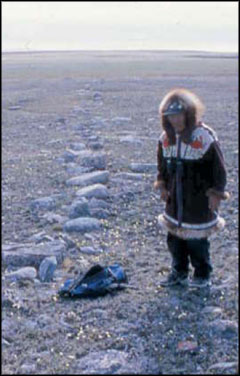
Tommy Kilaodluk at one of the oldest sections of the caribou drive lanes at Iqaluktuuq (Max Friesen).
Immediately after the fall fish run Iqaluktuurmiut hunted the caribou that were now starting to migrate south. The geography of Iqaluktuuq – narrow corridor of land between the ocean and the enormous lake Tahiryuaq – made it a natural funnel for migrating caribou. Evidence for large organized caribou hunts at Iqaluktuuq can be found in the archaeological sites and place names of the area.

The remains of a caribou drive system, including a long line of inuksuit and shooting blinds have been found on the north side of the river. These rows of inuksuit stretch for over three kilometres, all the way from Tahiryuaq to the ocean. Some sections are deeply buried and covered with lichen, and must have been built in ancient times, while other sections were probably built as recently as the 1920s. The caribou were driven by people, often women, into the funnel created by the inuksuit. The shooting blinds were located at the narrow end of the funnel so that the caribou would have to pass close to the hidden archers. Animals that made it past the shooting blinds and entered the water were pursued by men in kayaks, and killed with lances. Ayapqaut is the name of a place located just upstream of the caribou drive on the north shore (see map on page 2). It means “a place to steady your kayak”. The name preserves the memory of Inuit hunting caribou in kayaks at Iqaluktuuq, and the close association of this place with the caribou drive suggests that it may have been used at the same time.
After the fall fishing and caribou hunting, Iqaluktuurmiut would ideally have a winter’s supply of dry fish, whole fish, dried caribou meat, frozen caribou meat and skins for clothing. They left the Iqaluktuuq area to gather at innagharviit (“places of preparation”) where they would finish preparing their winter clothing and equipment before moving out on to the sea ice to spend the winter in seal hunting villages of iglus.